Competitive Strategy Analysis Report: Walmart and Coca-Cola Comparison
VerifiedAdded on 2020/03/04
|6
|1431
|133
Report
AI Summary
This report provides a detailed analysis of the competitive strategies employed by Walmart and Coca-Cola, two global industry leaders. It explores Walmart's success through its supply chain management, business model innovation, and ability to deliver convenience to consumers across various countries. The report also examines Coca-Cola's competitive advantages, focusing on its flexible business model, product innovation, and adaptation to changing market trends, including the use of big data. The CAGE framework is used to evaluate the challenges of distance in marketing and expansion, considering cultural, administrative, geographic, and economic factors for both companies. The report provides insights into how these companies navigate global markets, adapt their business models, and maintain their competitive positions. References are provided to support the analysis, making it a valuable resource for students studying business development and competitive strategy.
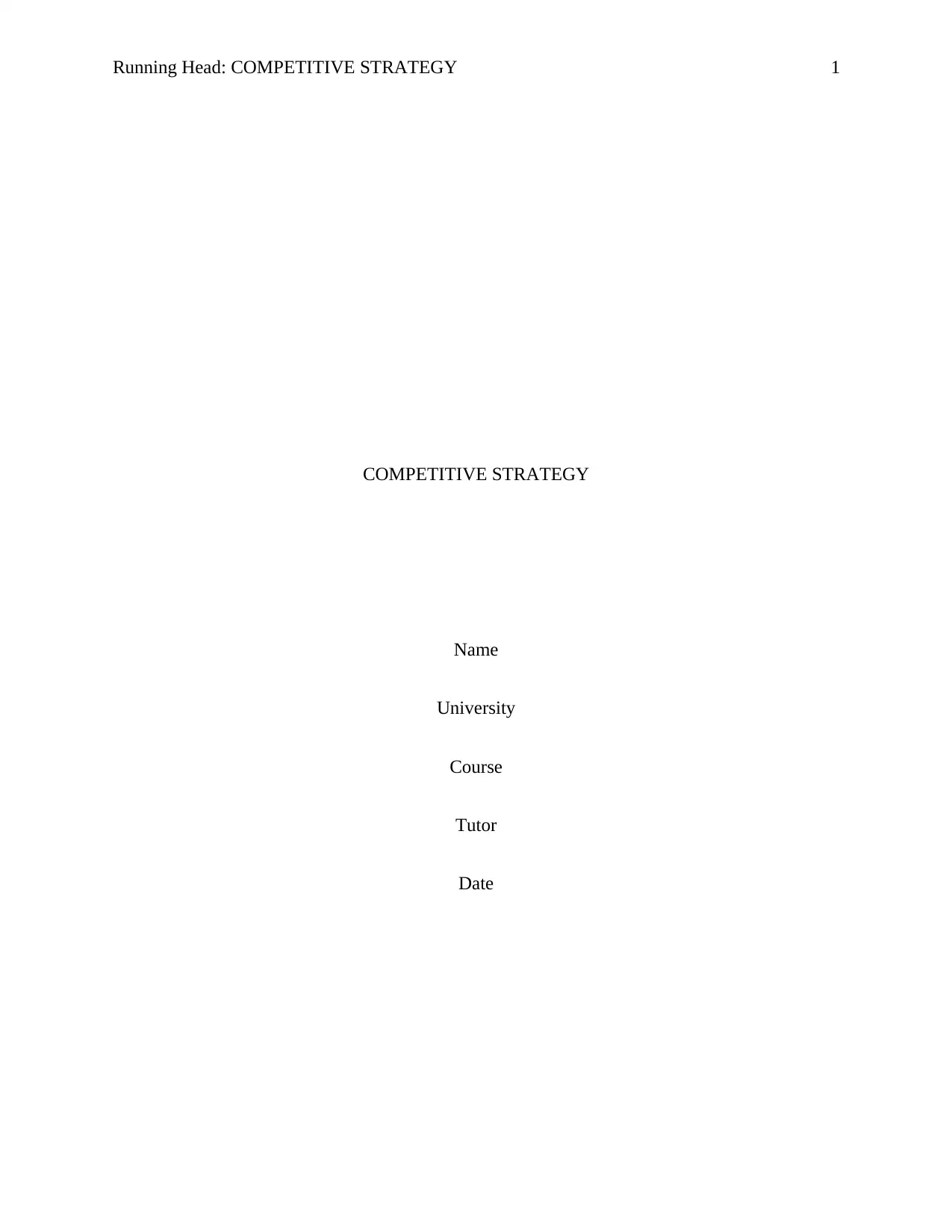
Running Head: COMPETITIVE STRATEGY 1
COMPETITIVE STRATEGY
Name
University
Course
Tutor
Date
COMPETITIVE STRATEGY
Name
University
Course
Tutor
Date
Paraphrase This Document
Need a fresh take? Get an instant paraphrase of this document with our AI Paraphraser
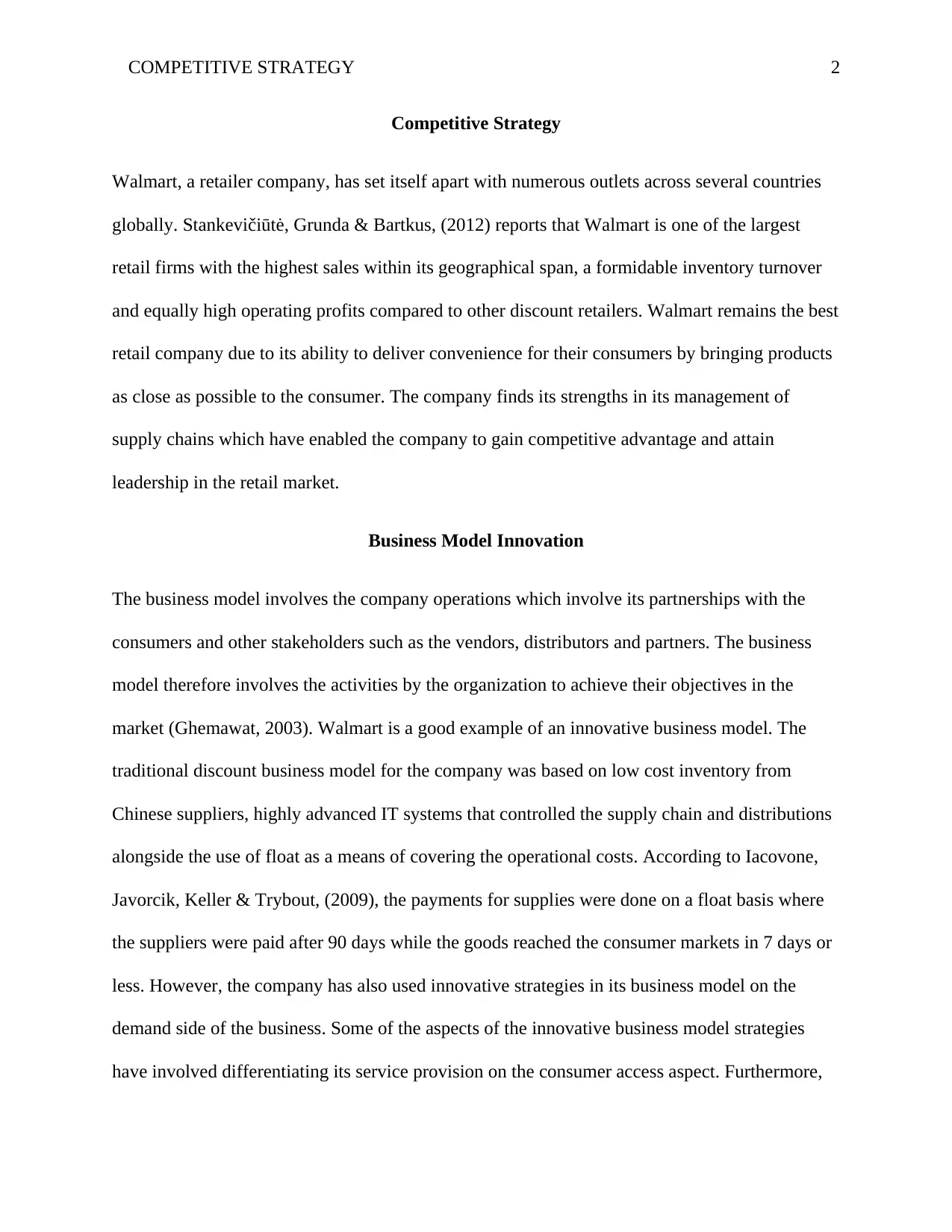
COMPETITIVE STRATEGY 2
Competitive Strategy
Walmart, a retailer company, has set itself apart with numerous outlets across several countries
globally. Stankevičiūtė, Grunda & Bartkus, (2012) reports that Walmart is one of the largest
retail firms with the highest sales within its geographical span, a formidable inventory turnover
and equally high operating profits compared to other discount retailers. Walmart remains the best
retail company due to its ability to deliver convenience for their consumers by bringing products
as close as possible to the consumer. The company finds its strengths in its management of
supply chains which have enabled the company to gain competitive advantage and attain
leadership in the retail market.
Business Model Innovation
The business model involves the company operations which involve its partnerships with the
consumers and other stakeholders such as the vendors, distributors and partners. The business
model therefore involves the activities by the organization to achieve their objectives in the
market (Ghemawat, 2003). Walmart is a good example of an innovative business model. The
traditional discount business model for the company was based on low cost inventory from
Chinese suppliers, highly advanced IT systems that controlled the supply chain and distributions
alongside the use of float as a means of covering the operational costs. According to Iacovone,
Javorcik, Keller & Trybout, (2009), the payments for supplies were done on a float basis where
the suppliers were paid after 90 days while the goods reached the consumer markets in 7 days or
less. However, the company has also used innovative strategies in its business model on the
demand side of the business. Some of the aspects of the innovative business model strategies
have involved differentiating its service provision on the consumer access aspect. Furthermore,
Competitive Strategy
Walmart, a retailer company, has set itself apart with numerous outlets across several countries
globally. Stankevičiūtė, Grunda & Bartkus, (2012) reports that Walmart is one of the largest
retail firms with the highest sales within its geographical span, a formidable inventory turnover
and equally high operating profits compared to other discount retailers. Walmart remains the best
retail company due to its ability to deliver convenience for their consumers by bringing products
as close as possible to the consumer. The company finds its strengths in its management of
supply chains which have enabled the company to gain competitive advantage and attain
leadership in the retail market.
Business Model Innovation
The business model involves the company operations which involve its partnerships with the
consumers and other stakeholders such as the vendors, distributors and partners. The business
model therefore involves the activities by the organization to achieve their objectives in the
market (Ghemawat, 2003). Walmart is a good example of an innovative business model. The
traditional discount business model for the company was based on low cost inventory from
Chinese suppliers, highly advanced IT systems that controlled the supply chain and distributions
alongside the use of float as a means of covering the operational costs. According to Iacovone,
Javorcik, Keller & Trybout, (2009), the payments for supplies were done on a float basis where
the suppliers were paid after 90 days while the goods reached the consumer markets in 7 days or
less. However, the company has also used innovative strategies in its business model on the
demand side of the business. Some of the aspects of the innovative business model strategies
have involved differentiating its service provision on the consumer access aspect. Furthermore,
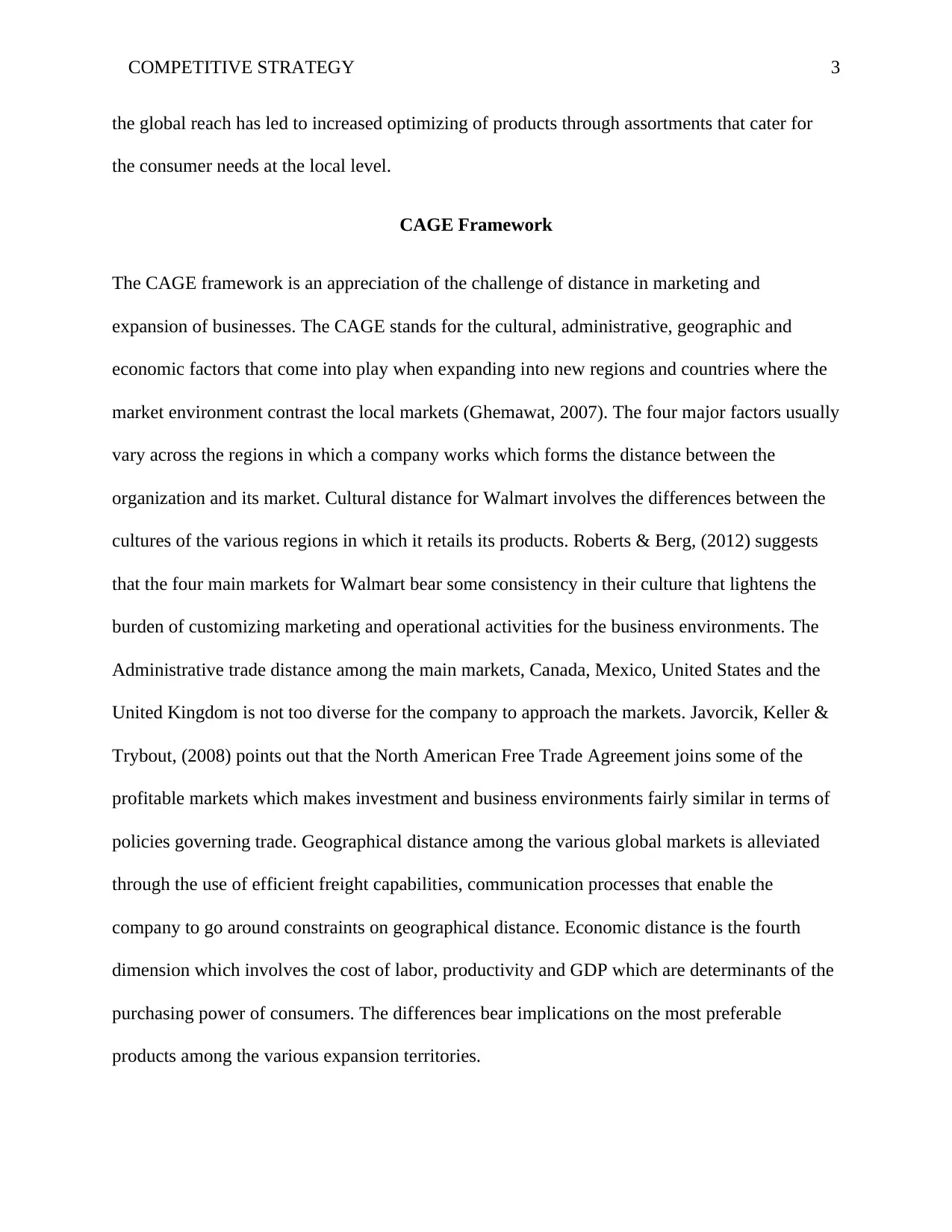
COMPETITIVE STRATEGY 3
the global reach has led to increased optimizing of products through assortments that cater for
the consumer needs at the local level.
CAGE Framework
The CAGE framework is an appreciation of the challenge of distance in marketing and
expansion of businesses. The CAGE stands for the cultural, administrative, geographic and
economic factors that come into play when expanding into new regions and countries where the
market environment contrast the local markets (Ghemawat, 2007). The four major factors usually
vary across the regions in which a company works which forms the distance between the
organization and its market. Cultural distance for Walmart involves the differences between the
cultures of the various regions in which it retails its products. Roberts & Berg, (2012) suggests
that the four main markets for Walmart bear some consistency in their culture that lightens the
burden of customizing marketing and operational activities for the business environments. The
Administrative trade distance among the main markets, Canada, Mexico, United States and the
United Kingdom is not too diverse for the company to approach the markets. Javorcik, Keller &
Trybout, (2008) points out that the North American Free Trade Agreement joins some of the
profitable markets which makes investment and business environments fairly similar in terms of
policies governing trade. Geographical distance among the various global markets is alleviated
through the use of efficient freight capabilities, communication processes that enable the
company to go around constraints on geographical distance. Economic distance is the fourth
dimension which involves the cost of labor, productivity and GDP which are determinants of the
purchasing power of consumers. The differences bear implications on the most preferable
products among the various expansion territories.
the global reach has led to increased optimizing of products through assortments that cater for
the consumer needs at the local level.
CAGE Framework
The CAGE framework is an appreciation of the challenge of distance in marketing and
expansion of businesses. The CAGE stands for the cultural, administrative, geographic and
economic factors that come into play when expanding into new regions and countries where the
market environment contrast the local markets (Ghemawat, 2007). The four major factors usually
vary across the regions in which a company works which forms the distance between the
organization and its market. Cultural distance for Walmart involves the differences between the
cultures of the various regions in which it retails its products. Roberts & Berg, (2012) suggests
that the four main markets for Walmart bear some consistency in their culture that lightens the
burden of customizing marketing and operational activities for the business environments. The
Administrative trade distance among the main markets, Canada, Mexico, United States and the
United Kingdom is not too diverse for the company to approach the markets. Javorcik, Keller &
Trybout, (2008) points out that the North American Free Trade Agreement joins some of the
profitable markets which makes investment and business environments fairly similar in terms of
policies governing trade. Geographical distance among the various global markets is alleviated
through the use of efficient freight capabilities, communication processes that enable the
company to go around constraints on geographical distance. Economic distance is the fourth
dimension which involves the cost of labor, productivity and GDP which are determinants of the
purchasing power of consumers. The differences bear implications on the most preferable
products among the various expansion territories.
⊘ This is a preview!⊘
Do you want full access?
Subscribe today to unlock all pages.

Trusted by 1+ million students worldwide
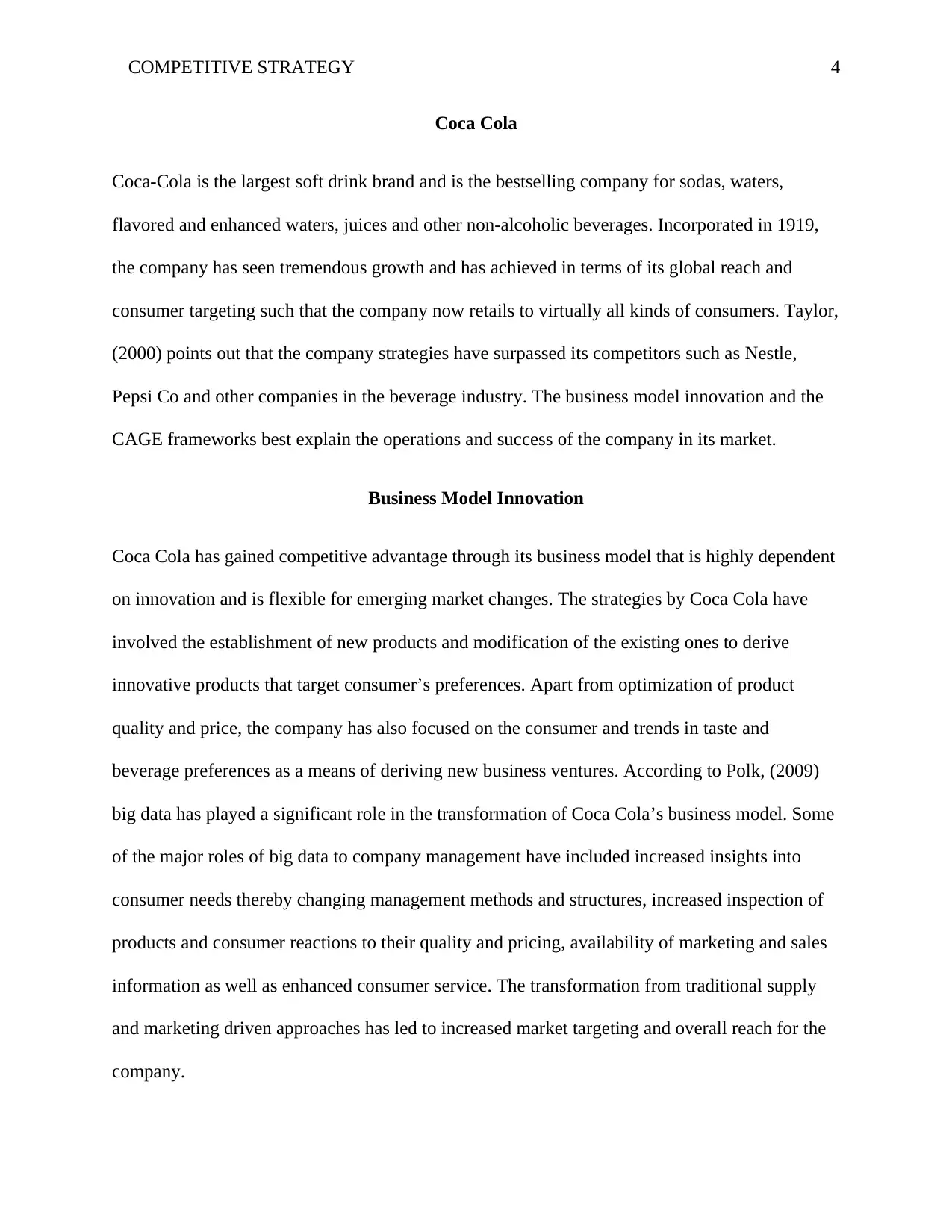
COMPETITIVE STRATEGY 4
Coca Cola
Coca-Cola is the largest soft drink brand and is the bestselling company for sodas, waters,
flavored and enhanced waters, juices and other non-alcoholic beverages. Incorporated in 1919,
the company has seen tremendous growth and has achieved in terms of its global reach and
consumer targeting such that the company now retails to virtually all kinds of consumers. Taylor,
(2000) points out that the company strategies have surpassed its competitors such as Nestle,
Pepsi Co and other companies in the beverage industry. The business model innovation and the
CAGE frameworks best explain the operations and success of the company in its market.
Business Model Innovation
Coca Cola has gained competitive advantage through its business model that is highly dependent
on innovation and is flexible for emerging market changes. The strategies by Coca Cola have
involved the establishment of new products and modification of the existing ones to derive
innovative products that target consumer’s preferences. Apart from optimization of product
quality and price, the company has also focused on the consumer and trends in taste and
beverage preferences as a means of deriving new business ventures. According to Polk, (2009)
big data has played a significant role in the transformation of Coca Cola’s business model. Some
of the major roles of big data to company management have included increased insights into
consumer needs thereby changing management methods and structures, increased inspection of
products and consumer reactions to their quality and pricing, availability of marketing and sales
information as well as enhanced consumer service. The transformation from traditional supply
and marketing driven approaches has led to increased market targeting and overall reach for the
company.
Coca Cola
Coca-Cola is the largest soft drink brand and is the bestselling company for sodas, waters,
flavored and enhanced waters, juices and other non-alcoholic beverages. Incorporated in 1919,
the company has seen tremendous growth and has achieved in terms of its global reach and
consumer targeting such that the company now retails to virtually all kinds of consumers. Taylor,
(2000) points out that the company strategies have surpassed its competitors such as Nestle,
Pepsi Co and other companies in the beverage industry. The business model innovation and the
CAGE frameworks best explain the operations and success of the company in its market.
Business Model Innovation
Coca Cola has gained competitive advantage through its business model that is highly dependent
on innovation and is flexible for emerging market changes. The strategies by Coca Cola have
involved the establishment of new products and modification of the existing ones to derive
innovative products that target consumer’s preferences. Apart from optimization of product
quality and price, the company has also focused on the consumer and trends in taste and
beverage preferences as a means of deriving new business ventures. According to Polk, (2009)
big data has played a significant role in the transformation of Coca Cola’s business model. Some
of the major roles of big data to company management have included increased insights into
consumer needs thereby changing management methods and structures, increased inspection of
products and consumer reactions to their quality and pricing, availability of marketing and sales
information as well as enhanced consumer service. The transformation from traditional supply
and marketing driven approaches has led to increased market targeting and overall reach for the
company.
Paraphrase This Document
Need a fresh take? Get an instant paraphrase of this document with our AI Paraphraser
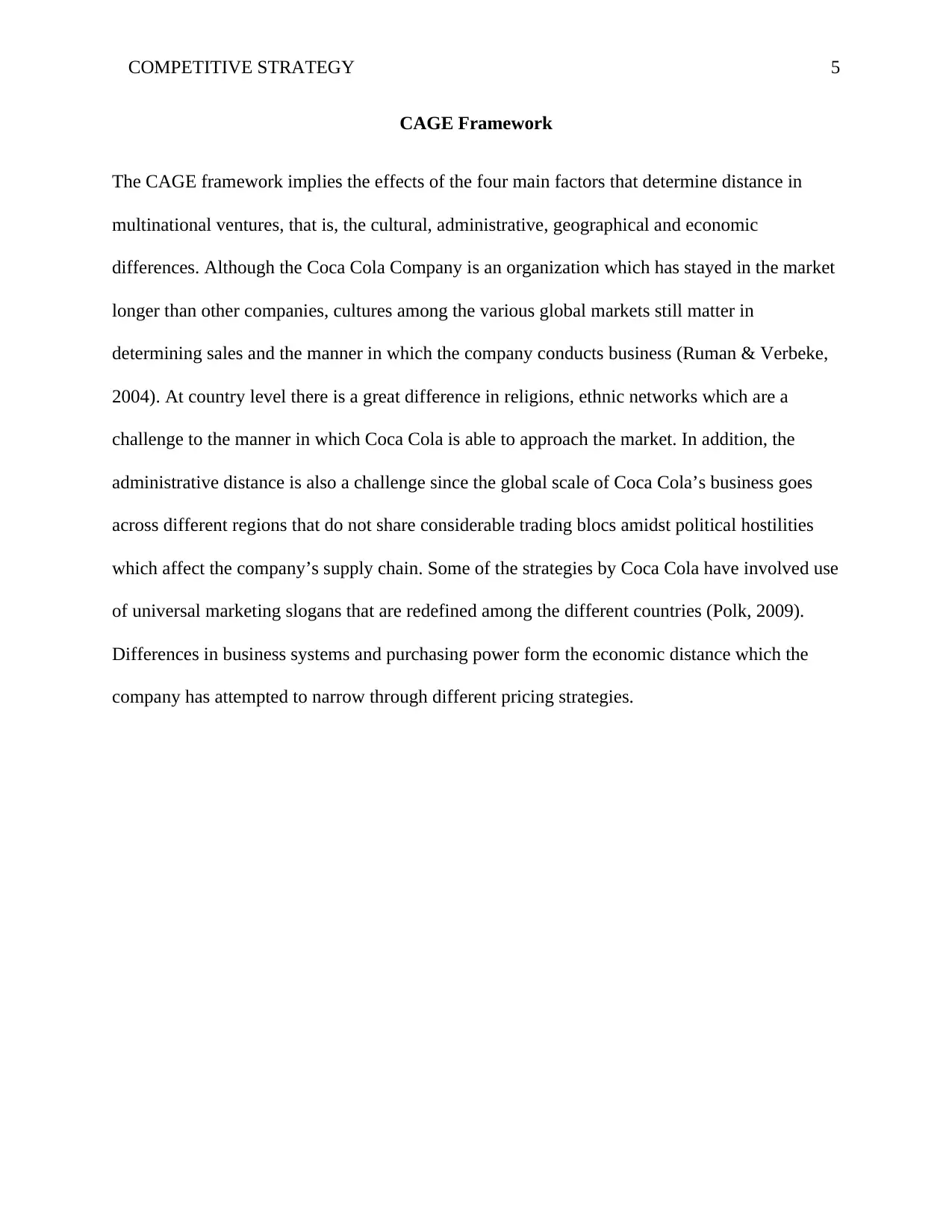
COMPETITIVE STRATEGY 5
CAGE Framework
The CAGE framework implies the effects of the four main factors that determine distance in
multinational ventures, that is, the cultural, administrative, geographical and economic
differences. Although the Coca Cola Company is an organization which has stayed in the market
longer than other companies, cultures among the various global markets still matter in
determining sales and the manner in which the company conducts business (Ruman & Verbeke,
2004). At country level there is a great difference in religions, ethnic networks which are a
challenge to the manner in which Coca Cola is able to approach the market. In addition, the
administrative distance is also a challenge since the global scale of Coca Cola’s business goes
across different regions that do not share considerable trading blocs amidst political hostilities
which affect the company’s supply chain. Some of the strategies by Coca Cola have involved use
of universal marketing slogans that are redefined among the different countries (Polk, 2009).
Differences in business systems and purchasing power form the economic distance which the
company has attempted to narrow through different pricing strategies.
CAGE Framework
The CAGE framework implies the effects of the four main factors that determine distance in
multinational ventures, that is, the cultural, administrative, geographical and economic
differences. Although the Coca Cola Company is an organization which has stayed in the market
longer than other companies, cultures among the various global markets still matter in
determining sales and the manner in which the company conducts business (Ruman & Verbeke,
2004). At country level there is a great difference in religions, ethnic networks which are a
challenge to the manner in which Coca Cola is able to approach the market. In addition, the
administrative distance is also a challenge since the global scale of Coca Cola’s business goes
across different regions that do not share considerable trading blocs amidst political hostilities
which affect the company’s supply chain. Some of the strategies by Coca Cola have involved use
of universal marketing slogans that are redefined among the different countries (Polk, 2009).
Differences in business systems and purchasing power form the economic distance which the
company has attempted to narrow through different pricing strategies.
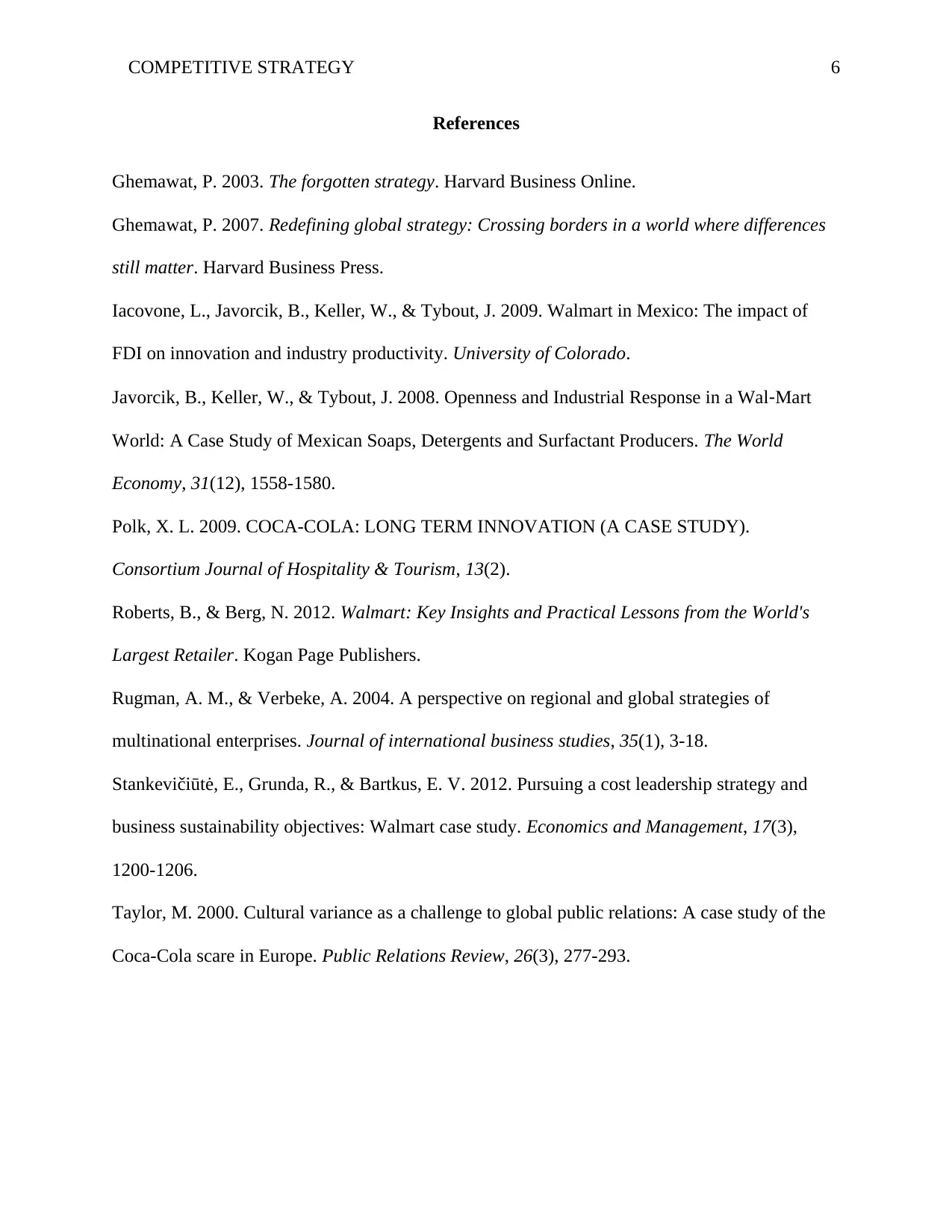
COMPETITIVE STRATEGY 6
References
Ghemawat, P. 2003. The forgotten strategy. Harvard Business Online.
Ghemawat, P. 2007. Redefining global strategy: Crossing borders in a world where differences
still matter. Harvard Business Press.
Iacovone, L., Javorcik, B., Keller, W., & Tybout, J. 2009. Walmart in Mexico: The impact of
FDI on innovation and industry productivity. University of Colorado.
Javorcik, B., Keller, W., & Tybout, J. 2008. Openness and Industrial Response in a Wal‐Mart
World: A Case Study of Mexican Soaps, Detergents and Surfactant Producers. The World
Economy, 31(12), 1558-1580.
Polk, X. L. 2009. COCA-COLA: LONG TERM INNOVATION (A CASE STUDY).
Consortium Journal of Hospitality & Tourism, 13(2).
Roberts, B., & Berg, N. 2012. Walmart: Key Insights and Practical Lessons from the World's
Largest Retailer. Kogan Page Publishers.
Rugman, A. M., & Verbeke, A. 2004. A perspective on regional and global strategies of
multinational enterprises. Journal of international business studies, 35(1), 3-18.
Stankevičiūtė, E., Grunda, R., & Bartkus, E. V. 2012. Pursuing a cost leadership strategy and
business sustainability objectives: Walmart case study. Economics and Management, 17(3),
1200-1206.
Taylor, M. 2000. Cultural variance as a challenge to global public relations: A case study of the
Coca-Cola scare in Europe. Public Relations Review, 26(3), 277-293.
References
Ghemawat, P. 2003. The forgotten strategy. Harvard Business Online.
Ghemawat, P. 2007. Redefining global strategy: Crossing borders in a world where differences
still matter. Harvard Business Press.
Iacovone, L., Javorcik, B., Keller, W., & Tybout, J. 2009. Walmart in Mexico: The impact of
FDI on innovation and industry productivity. University of Colorado.
Javorcik, B., Keller, W., & Tybout, J. 2008. Openness and Industrial Response in a Wal‐Mart
World: A Case Study of Mexican Soaps, Detergents and Surfactant Producers. The World
Economy, 31(12), 1558-1580.
Polk, X. L. 2009. COCA-COLA: LONG TERM INNOVATION (A CASE STUDY).
Consortium Journal of Hospitality & Tourism, 13(2).
Roberts, B., & Berg, N. 2012. Walmart: Key Insights and Practical Lessons from the World's
Largest Retailer. Kogan Page Publishers.
Rugman, A. M., & Verbeke, A. 2004. A perspective on regional and global strategies of
multinational enterprises. Journal of international business studies, 35(1), 3-18.
Stankevičiūtė, E., Grunda, R., & Bartkus, E. V. 2012. Pursuing a cost leadership strategy and
business sustainability objectives: Walmart case study. Economics and Management, 17(3),
1200-1206.
Taylor, M. 2000. Cultural variance as a challenge to global public relations: A case study of the
Coca-Cola scare in Europe. Public Relations Review, 26(3), 277-293.
⊘ This is a preview!⊘
Do you want full access?
Subscribe today to unlock all pages.

Trusted by 1+ million students worldwide
1 out of 6
Related Documents
Your All-in-One AI-Powered Toolkit for Academic Success.
+13062052269
info@desklib.com
Available 24*7 on WhatsApp / Email
![[object Object]](/_next/static/media/star-bottom.7253800d.svg)
Unlock your academic potential
Copyright © 2020–2025 A2Z Services. All Rights Reserved. Developed and managed by ZUCOL.





